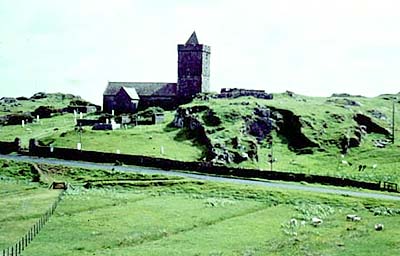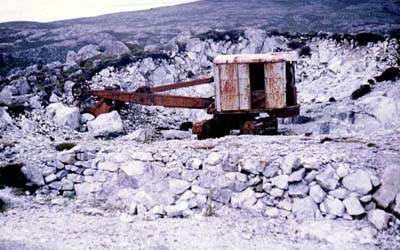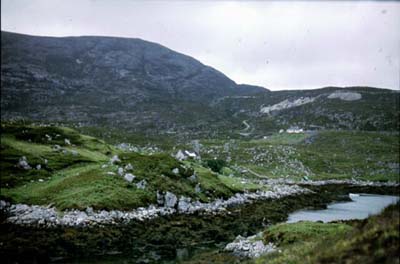
PART V: ECONOMIC GEOLOGY
Three rock types from this area have been commercially exploited. The limestones of the Rodel area have been quarried for building stone, and St. Clement's Church is built principally of blocks of the limestone (or 'Rodel granite' as it was locally known).

St Clements Church, Rodel, July 1974
The anorthosite of the Lingerbay area was quarried during the second world war for white rock powder, used as a filler or abrasive. Apparently the exploitation was abandoned "because of the presence of laths of biotite" (Berridge 1969 p.l6), but there is little if any biotite visible in the anorthosite, which is virtually pure at this locality. Presumably the true reason for the abandonment of workings was economic, however Berridge (1969) 1s optimistic about the chancea of exploitation starting again in the near future.

World War II quarrying equipment in a pegmatite quarry on Sletteval, near Lingerbay, July 1974
The Sletteval pegmatite was also quarried during the war for potash feldspar, used in the ceramics industry mainly for electrical porcelain. During the period in which it was quarried it supplied most of the United Kingdom's needs for this mineral. However the cost of extracting the potash feldspar was much greater than that of importing the mineral, and the colour of the porcelain was inferior (Robertson, 1943 pp.1,3).

Lingerbay from near Lingerbay Island, showing quarrying scars on the slopes of Roneval, behind.
The pegmatites, however, contain relatively high concentrations of uranium, thorium, niobium and tantalum (von Knorring and, Dearnley, 1971) and it is conceivable that they might be worked commercially for these elements in the future (Berridge, 1969 p. 20).
Apart from these economic usages there is a vein of magnetite, about 1 inch thick near Lingerbay road end (Berridge, 1969 p.17) and there has been a renewed interest in the granite pegmatites recently.